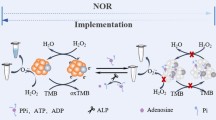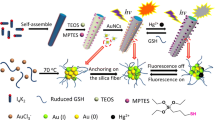Abstract
Proteins are excellent templates and stabilizers for Au nanoclusters (NCs) because of their abundant thiol groups and unique internal environments. However, high-molecular weight (MW) proteins with special quaternary structures are rarely reported as such templates. Considering that proteins may afford different spatial configurations as templates for Au NCs, we focused on alkaline phosphatase, catalase, and fibrinogen (MW range from 150 to 340 kDa) as direct templates for synthesizing Au NCs. We demonstrated that both Cu2+ and Hg2+ could induce photoluminescence (PL) quenching of these Au NCs, while their binding mechanisms were different. Therefore, significant PL recovery by amino acids, e.g., histidine and cysteine, was observed for Cu2+-treated Au NCs, but not Hg2+-treated Au NCs, allowing for selective detection of Hg2+ by using histidine as a masking agent. The detection ranges were 0.06–2.0 μM for Hg2+ and 0.04–5.0 μM for Cu2+, with low limits of detection of 0.02 and 0.01 μM, respectively. The PL change showed opposite tendency for histidine and cysteine at higher concentrations, resulting in different PL outputs. Using dual metal ion and dual amino acid combinations, an integrated PL logic gate was fabricated. This work improves the understanding of the PL mechanisms of complicated protein-localized Au NCs.

Similar content being viewed by others
References
Yau, S. H.; Varnavski, O.; Goodson, T. An ultrafast look at Au nanoclusters. Acc. Chem. Res. 2013, 46, 1506–1516.
Palmal, S.; Jana, N. R. Gold nanoclusters with enhanced tunable fluorescence as bioimaging probes. Wiley Interdiscip. Rev. Nanomed. Nanobiotechnol. 2014, 6, 102–110.
Sarparast, M.; Noori, A.; Ilkhani, H.; Bathaie, S. Z.; El-Kady, M. F.; Wang, L. J.; Pham, H.; Marsh, K. L.; Kaner, R. B.; Mousavi, M. F. Cadmium nanoclusters in a protein matrix: Synthesis, characterization, and application in targeted drug delivery and cellular imaging. Nano Res. 2016, 9, 3229–3246.
Yuan, X.; Goswami, N.; Mathews, I.; Yu, Y.; Xie, J. P. Enhancing stability through ligand-shell engineering: A case study with Au25(SR)18 nanoclusters. Nano Res. 2015, 8, 3488–3495.
Xie, J. P.; Zheng, Y. G.; Ying, J. Y. Protein-directed synthesis of highly fluorescent gold nanoclusters. J. Am. Chem. Soc. 2009, 131, 888–889.
Baksi, A.; Xavier, P. L.; Chaudhari, K.; Goswami, N.; Pal, S. K.; Pradeep, T. Protein-encapsulated gold cluster aggregates: The case of lysozyme. Nanoscale 2013, 5, 2009–2016.
Chen, T.-H.; Tseng, W.-L. (Lysozyme type VI)-stabilized Au8 clusters: Synthesis mechanism and application for sensing of glutathione in a single drop of blood. Small 2012, 8, 1912–1919.
Kawasaki, H.; Hamaguchi, K.; Osaka, I.; Arakawa, R. pHdependent synthesis of pepsin-mediated gold nanoclusters with blue green and red fluorescent emission. Adv. Funct. Mater. 2011, 21, 3508–3515.
Zou, L. H.; Qi, W.; Huang, R. L.; Su, R. X.; Wang, M. F.; He, Z. M. Green synthesis of a gold nanoparticle-nanocluster composite nanostructures using trypsin as linking and reducing agents. ACS SustainableChem. Eng. 2013, 1, 1398–1404.
Shamsipur, M.; Molaabasi, F.; Shanehsaz, M.; Moosavi-Movahedi, A. A. Novel blue-emitting gold nanoclusters confined in human hemoglobin, and their use as fluorescent probes for copper(II) and histidine. Microchim. Acta 2015, 182, 1131–1141.
Selvaprakash, K.; Chen, Y. C. Using protein-encapsulated gold nanoclusters as photoluminescent sensing probes for biomolecules. Biosens. Bioelectron. 2014, 61, 88–94.
Zhang, P.; Lan, J.; Wang, Y.; Xiong, Z. H.; Huang, C. Z. Luminescent golden silk and fabric through in situ chemically coating pristine-silk with gold nanoclusters. Biomaterials 2015, 36, 26–32.
Russell, B. A.; Kubiak-Ossowska, K.; Mulheran, P. A.; Birch, D. J. S.; Chen, Y. Locating the nucleation sites for protein encapsulated gold nanoclusters: A molecular dynamics and fluorescence study. Phys. Chem. Chem. Phys. 2015, 17, 21935–21941.
Zhang, D. Y.; Chen, Z.; Omar, H.; Deng, L.; Khashab, N. M. Colorimetric peroxidase mimetic assay for uranyl detection in sea water. ACS Appl. Mater. Interfaces 2015, 7, 4589–4594.
Shamsipur, M.; Molaabasi, F.; Hosseinkhani, S.; Rahmati, F. Detection of early stage apoptotic cells based on label-free cytochrome c assay using bioconjugated metal nanoclusters as fluorescent probes. Anal. Chem. 2016, 88, 2188–2197.
West, A. L.; Griep, M. H.; Cole, D. P.; Karna, S. P. Dnase 1 retains endodeoxyribonuclease activity following gold nanocluster synthesis. Anal. Chem. 2014, 86, 7377–7382.
Ding, H.; Yang, D. Y.; Zhao, C.; Song, Z. K.; Liu, P. C.; Wang, Y.; Chen, Z. J.; Shen, J. C. Protein-gold hybrid nanocubes for cell imaging and drug delivery. ACS Appl. Mater. Interfaces 2015, 7, 4713–4719.
Xie, J. P.; Zheng, Y. G.; Ying, J. Y. Highly selective and ultrasensitive detection of Hg2+ based on fluorescence quenching of Au nanoclusters by Hg2+-Au+ interactions. Chem. Commun. 2010, 46, 961–963.
Hofmann, C. M.; Essner, J. B.; Baker, G. A.; Baker, S. N. Protein-templated gold nanoclusters sequestered within sol-gel thin films for the selective and ratiometric luminescence recognition of Hg2+. Nanoscale 2014, 6, 5425–5431.
Durgadas, C. V.; Sharma, C. P.; Sreenivasan, K. Fluorescent gold clusters as nanosensors for copper ions in live cells. Analyst 2011, 136, 933–940.
Lin, Z. J.; Luo, F. Q.; Dong, T. Q.; Zheng, L. Y.; Wang, Y. X.; Chi, Y. W.; Chen, G. N. Recyclable fluorescent gold nanocluster membrane for visual sensing of copper(II) ion in aqueous solution. Analyst 2012, 137, 2394–2399.
Liu, X.; Fu, C. H.; Ren, X. L.; Liu, H. Y.; Li, L. L.; Meng, X. W. Fluorescence switching method for cascade detection of salicylaldehyde and zinc(II) ion using protein protected gold nanoclusters. Biosens. Bioelectron. 2015, 74, 322–328.
Xu, Y. L.; Sherwood, J.; Qin, Y.; Crowley, D.; Bonizzoni, M.; Bao, Y. P. The role of protein characteristics in the formation and fluorescence of Au nanoclusters. Nanoscale 2014, 6, 1515–1524.
Sun, C. J.; Yang, H.; Yuan, Y.; Tian, X.; Wang, L. M.; Guo, Y.; Xu, L.; Lei, J. L.; Gao, N.; Anderson, G. J. et al. Controlling assembly of paired gold clusters within apoferritin nanoreactor for in vivo kidney targeting and biomedical imaging. J. Am. Chem. Soc. 2011, 133, 8617–8624.
Volden, S.; Lystvet, S. M.; Halskau, Ø.; Glomm, W. R. Generally applicable procedure for in situ formation of fluorescent protein-gold nanoconstructs. RSC Adv. 2012, 2, 11704–11711.
Sun, C. J.; Yuan, Y.; Xu, Z. H.; Ji, T. J.; Tian, Y. H.; Wu, S.; Lei, J. L.; Li, J. Y.; Gao, N.; Nie, G. J. Fine-tuned H-ferritin nanocage with multiple gold clusters as near-infrared kidney specific targeting nanoprobe. Bioconjugate Chem. 2015, 26, 193–196.
Baksi, A.; Mitra, A.; Mohanty, J. S.; Lee, H.; De, G.; Pradeep, T. Size evolution of protein-protected gold clusters in solution: A combined SAXS-MS investigation. J. Phys. Chem. C 2015, 119, 2148–2157.
Zaccheo, B. A.; Crooks, R. M. Stabilization of alkaline phosphatase with Au@Ag2O nanoparticles. Langmuir 2011, 27, 11591–11596.
Si, Y. M.; Sun, Z. Z.; Zhang, N.; Qi, W.; Li, S. Y.; Chen, L. J.; Wang, H. Ultrasensitive electroanalysis of low-level free micrornas in blood by maximum signal amplification of catalytic silver deposition using alkaline phosphataseincorporated gold nanoclusters. Anal. Chem. 2014, 86, 10406–10414.
Zhao, Q.; Chen, S. N.; Zhang, L. Y.; Huang, H. W.; Zeng, Y. L.; Liu, F. P. Multiplex sensor for detection of different metal ions based on on-off of fluorescent gold nanoclusters. Anal. Chim. Acta 2014, 852, 236–243.
Han, Y. Y.; Ding, C. Q.; Zhou, J.; Tian, Y. Single probe for imaging and biosensing of pH, Cu2+ ions, and pH/Cu2+ in live cells with ratiometric fluorescence signals. Anal. Chem. 2015, 87, 5333–5339.
Yan, Y. H.; Yu, H.; Zhang, K.; Sun, M. T.; Zhang, Y. J.; Wang, X. K.; Wang, S. H. Dual-emissive nanohybrid of carbon dots and gold nanoclusters for sensitive determination of mercuric ions. Nano Res. 2016, 9, 2088–2096.
Ghosh, S.; Anand, U.; Mukherjee, S. Luminescent silver nanoclusters acting as a label-free photoswitch in metal ion sensing. Anal. Chem. 2014, 86, 3188–3194.
Yu, P.; Wen, X. M.; Toh, Y.-R.; Huang, J.; Tang, J. Metallophilic bond-induced quenching of delayed fluorescence in Au25@BSA nanoclusters. Part. Part. Syst. Char. 2013, 30, 467–472.
Zheng, X. Y.; Yao, T. M.; Zhu, Y.; Shi, S. Cu2+ modulated silver nanoclusters as an on-off-on fluorescence probe for the selective detection of L-histidine. Biosens. Bioelectron. 2015, 66, 103–108.
Rigo, A.; Corazza, A.; di Paolo, M. L.; Rossetto, M.; Ugolini, R.; Scarpa, M. Interaction of copper with cysteine: Stability of cuprous complexes and catalytic role of cupric ions in anaerobic thiol oxidation. J. Inorg. Biochem. 2004, 98, 1495–1501.
Morishita, K.; MacLean, J. L.; Liu, B. W.; Jiang, H.; Liu, J. W. Correlation of photobleaching, oxidation and metal induced fluorescence quenching of DNA-templated silver nanoclusters. Nanoscale 2013, 5, 2840–2849.
Sun, J.; Yang, F.; Zhao, D.; Chen, C. X.; Yang, X. R. Integrated logic gate for fluorescence turn-on detection of histidine and cysteine based on Ag/Au bimetallic nanoclusters- Cu2+ ensemble. ACS Appl. Mater. Interfaces 2015, 7, 6860–6866.
Acknowledgements
This work was financially supported by the National High Technology Research and Development Program of China (No. 2015AA020502), the National Natural Science Foundation of China (Nos. 81325011, 21675023, and 21327902), Jiangsu Natural Science Foundation (No. BK20161413), and the Fundamental Research Funds for the Central Universities (No. 2242016K41023).
Author information
Authors and Affiliations
Corresponding authors
Electronic supplementary material
12274_2017_1633_MOESM1_ESM.pdf
Design of dual metal ions/dual amino acids integrated photoluminescent logic gate by high-molecular weight protein-localized Au nanoclusters
Rights and permissions
About this article
Cite this article
Liu, L., Jiang, H. & Wang, X. Design of dual metal ions/dual amino acids integrated photoluminescent logic gate by high-molecular weight protein-localized Au nanoclusters. Nano Res. 11, 311–322 (2018). https://doi.org/10.1007/s12274-017-1633-0
Received:
Revised:
Accepted:
Published:
Issue Date:
DOI: https://doi.org/10.1007/s12274-017-1633-0




